
|
|

April 25, 2008
WKDM 1380/WWRU 1660, Carlstadt, NJ
In this week's installment of Tower Site of the Week, we continue to dig through our archives to catch up on some of the many fascinating studio and transmitter sites in the biggest radio market in America.
This week, we visit a site that seems to keep sprouting towers every time we drive by. Over the course of the six decades that there's been a transmitter site here at 350 Paterson Plank Road in Carlstadt, just north of present-day Giants Stadium, it's grown from three towers to eight - and from 5 kW of total transmitter power to 23 kW.
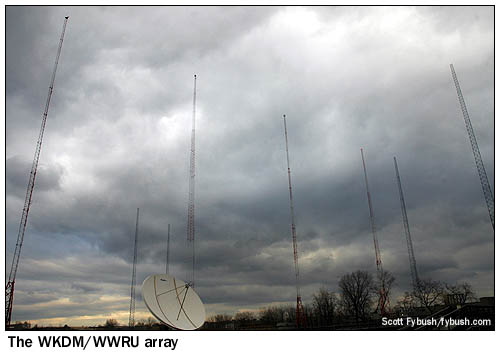
The history, of course, first: this site was built in 1947 for what was then WBNX (1380 New York), an ethnic station with roots in the Bronx (as its calls would suggest) and studios in Manhattan. WBNX was then a 5000-watt, DA-1 facility beaming most of its power south and east from the Meadowlands over the Hudson River and New York City. It shared time with religious WAWZ (1380 Zarephath NJ) down in Somerset County, which operated for a few hours each weekday and for most of Sunday. (At least one other station on 1380, WAMS in Wilmington, Delaware, had to shift its directional pattern slightly to protect whichever of the New Jersey 1380 transmitters was on the air at any given hour.)
By the time WAWZ folded its AM operation in late 1984, 1380 had become WKDM, still broadcasting in Spanish. It was around this time that the studios moved out here from Manhattan, with a new studio/office structure (in the foreground, below) being added to the original 1947 transmitter building (at left, below). In later years, WKDM would change calls to WNNY (with a Spanish-language all-news format), then to WLXE (with a regional Mexican format), and eventually back to WKDM in 2003 as the station changed hands from Mega Communications back to Multicultural Broadcasting, which had owned the station previously.
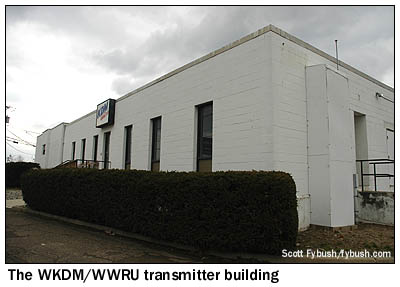 |
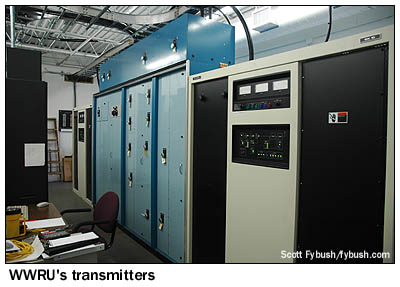 |
By then, this site was home to a second station. WWRU (1660 Jersey City) was one of the earliest signals on the expanded AM band, debuting in December 1995 as the expanded-band sister to WJDM (1530 Elizabeth) and transmitting from the WJDM tower. (Useless trivia, but a point of pride nonetheless: one of the first shows broadcast on the new "WJDM-EB" in 1995 was a simulcast of the shortwave show "Spectrum," and as the newscaster on the show, your editor can claim to have broadcast the very first newscast ever heard on the expanded AM band.)
For all of the high-minded talk about how full-time expanded-band service was urgently needed in Elizabeth, 1660 soon began to turn its attention to the big city to the northeast, and it turned out that the short stick in Elizabeth didn't make for a very good New York signal. As the station changed ownership (to Radio Unica, then to Multicultural), it changed city of license to Jersey City, and began moving its transmitter up here to Carlstadt. Daytime came first, as 1660 (by then WWRU) began operating with 10 kW non-directional from one of the WKDM towers, then eventually went directional, using WKDM's towers 1 and 2 with 10 kW. At first, WWRU still operated at night from Elizabeth, but a few years ago it built four short (140-foot) towers in an oblong surrounding the WKDM three-tower array, operating from those towers with 10 kW at night. (In the photo at the top of the page, those are the two towers behind the satellite dish at left and the two at far right.)
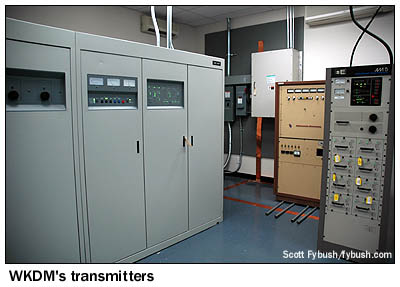 |
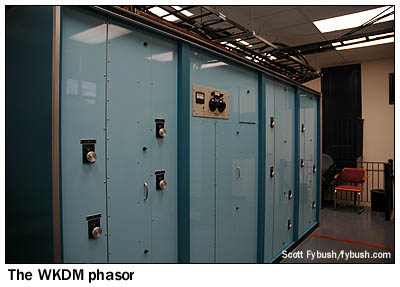 |
That accounts for seven towers - so what about the eighth? For that, we can credit Multicultural's recent upgrade of WKDM (which now broadcasts in Mandarin Chinese; WWRU is all Korean these days.) When we stopped by in January 2008, the station was just completing the buildout of a construction permit that will bump the 1380 signal up from 5 kW to 13 kW at night.
That required the construction of a fourth tower (third from right in the photo at the top of the page) and massive reconstruction of the entire transmission system out here, and it turned out to be quite the project.
Here's the current configuration: by day, WKDM remains on its three original towers with 5 kW, while WWRU uses WKDM's tower 2 and the new tower 4 with 10 kW. At night, WKDM uses all four of its towers with 13 kW, while WWRU's 10 kW night signal comes from the four short towers surrounding the WKDM array. And it gets even more complicated - because this site is within spitting distance of three 50 kW sites (WADO 1280 immediately to the west, WBBR 1130 to the east and WEPN 1050 to the south), the ATUs at the base of each tower have to not only filter the 1380 and 1660 signals from each other's transmitters, but also must detune these towers on those other frequencies. Still not complicated enough? OK - one of the WKDM night towers is a "negative" tower that actually absorbs some of the energy being radiated by the other three, which requires another run of transmission line to a dummy load at the back of the transmitter building to dissipate that energy.
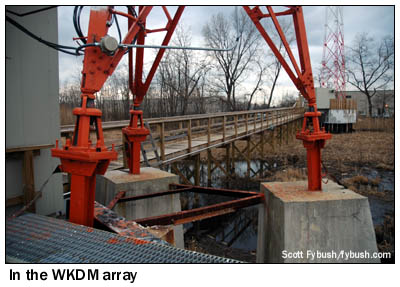 |
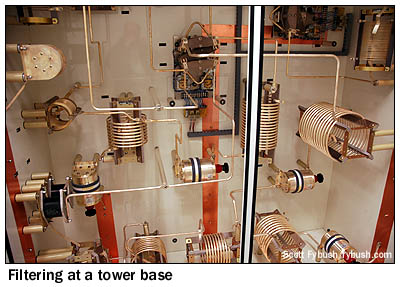 |
For such a complicated task, the industry leader is Kintronics, and Tom King and his crew outdid themselves building out the complex tuning and detuning system, which is installed in a brand-new shelter (air-conditioned, yet!) at the base of each WKDM tower.
The transmitter building itself has been extensively renovated as well. The original WKDM transmitter room, at the west end of the building, now houses three transmitters - the BE AM6 that was WKDM's 5 kW transmitter, a new Harris DX25U that's used for the 13 kW night operation, and a Continental that was WKDM's backup - as well as the new Kintronics phasor. The old studio/office space at the center of the building is being renovated as backup studios for Multicultural. And at the east end of the building, next to the parking lot, WWRU's two Harris DX10 transmitters flank its phasor. (That's an unusual phasor, by the way - when the WWRU day pattern was reworked to use towers 2 and 4, Kintronics had to build a new daytime phasor cabinet that's mounted on top of the old phasor!)
Next week, we'll get started on our multi-part recap of last year's big adventure, Big Trip 2007, as we begin exploring the sites of Salt Lake City.
Tower Site Calendar 2008 is almost sold out! Visit the Fybush.com Store now and get your calendar now!
- Previous Site of the Week: WFAS/WFAS-FM, White Plains
- Next Week: Big Trip 2007 Part I - Salt Lake City
- Site of the Week INDEX!
- How can you help support Site of the Week? Click here!
- Submit your suggestions for a future Site of the Week!
